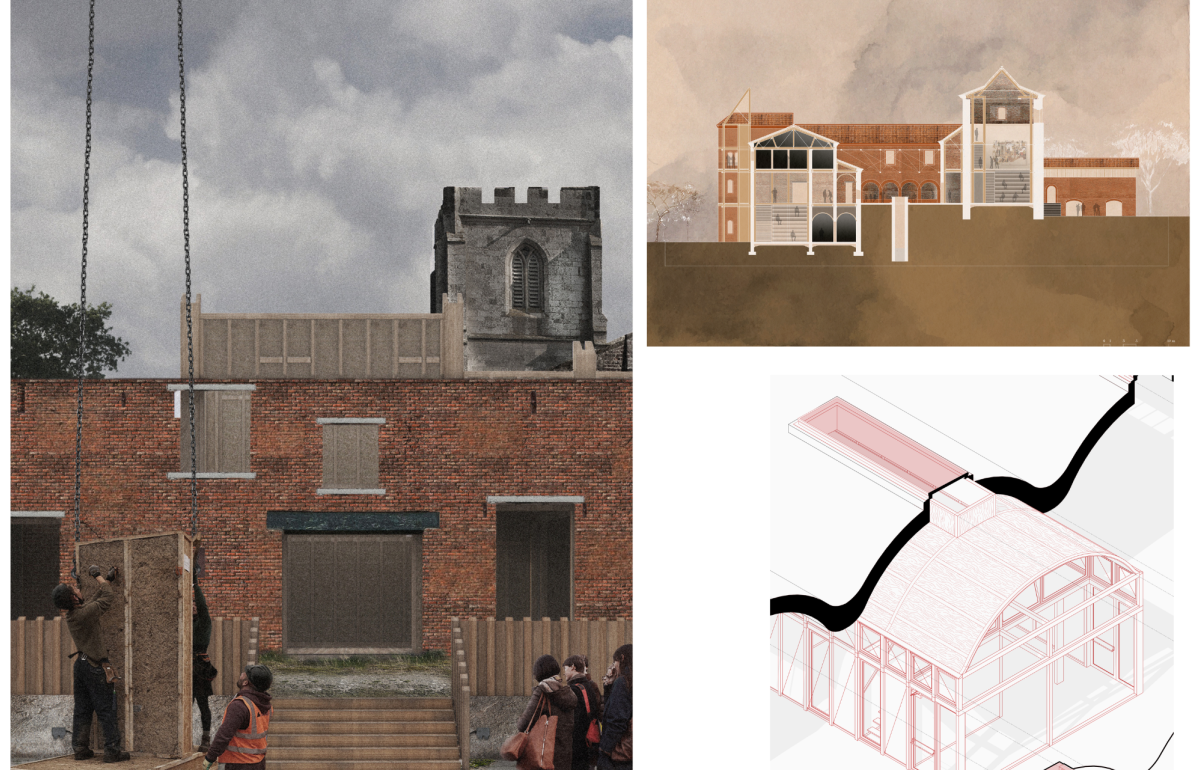Architecture graduates win design prizes for inventive schemes that re-imagine challenging historic spaces
Share on:
Three young architecture graduates have won the Society for the Protection of Ancient Building’s (SPAB) prestigious ‘new design in historic contexts’ award, the Philip Webb Award, for their separate schemes proving that with imagination and sensitivity you don’t need to demolish historic buildings.
The award invites students of architecture or recent graduates to engage with an old building and develop a scheme for its repair and sustainable future use without sacrificing the building’s unique character.
The winning and commended architects – all of whom completed their Part II studies in summer 2018 - chose to develop schemes for buildings or complexes with an uncertain future or which are currently subject to unsympathetic planning proposals.
This year’s first prize winner, Chris Hamill, a graduate of the University of Cambridge, tackled the contested site of disused Armagh Gaol.


Chris Hamill's scheme for Armagh Gaol, winner of the Philip Webb Award 2018
Chris’s project proposed to conserve the complex and establish a craft skills centre, whose students build temporary workshops there, which could form the basis of more permanent structures, but which would also be reversible to make way for other uses. The project keeps the site in repair and in use, while allowing the community time and scope to consider a long term future that respects its social and architectural significance, and negotiates its troubled history.
The project aims to bring together local communities and respect the sensitive history of the site, which was recently granted planning permission for conversion to spa and a hotel and wedding venue.
Chris Hamill said: ‘I am thrilled to have won this year’s Philip Webb award. It is extremely encouraging for the judges to agree that Northern Ireland’s conflict heritages are worth preserving through diligent conservation work, despite political obstacles and the sometimes-terrible memories these places evoke. Awareness of the challenges posed by contested heritage sites has grown in recent years but there is still ground to cover. Although there is no ‘one-size-fits-all’ solution, I remain firmly convinced that even by prompting conversations about difficult legacy issues, sites like Armagh Gaol have an important role to play in the continuing reconciliation between communities, two decades on from the Good Friday Agreement.’


Racael Moon's scheme for the it Head Baths at Chatterley Whitfield Collierry, Stoke; Joe Copp's scheme for the Bristol United Brewery Malt House
Second prize went to Rachael Moon, a graduate of Sheffield University, for her imaginative proposal to transform the Pit Head Baths at Chatterley Whitfield Colliery in Stoke-on-Trent, into as a public spa.
The Grade II listed building is in a poor state of repair and currently houses offices. Rachael’s proposed scheme is one more sensitive to the site’s original purpose as a large-scale welfare facility for miners.
Rachael Moon said: “The Chatterley Whitfield Pithead Baths is a prime example of early British modernism and progressive welfare reforms, and I am pleased to see the project’s ambition recognised. The aim is for the complex to open up its doors once more to the community, rekindling its relationship with both people and water. In stark contrast to the exclusive and luxurious spas of the modern era, the focus is a return to the core principles that define the essence of a more traditional public bathing experience. The project’s new interventions aim to celebrate a building of immense social and architectural significance.”
University of West England graduate Joe Copp was commended for his scheme to revive the Bristol United Brewery Malt House, a derelict industrial building scheduled for demolition on Bristol’s Floating Harbour.
Joe Copp said: "The underpinning agenda of this project sought to manage how the west end of Bristol’s Floating Harbour is continuing to transcend from its historical industrial use, towards a leisure and recreation space for the city. I felt it was important to consider how this social shift could be managed at the building scale – specifically, buildings that have been intentionally left to ruin and are now contested relics of the harbour’s industrial past. The project explored the idea that conservation and re-use might follow the pragmatic tone established by the harbour’s own historical development."
These three schemes put the spirit of the historic buildings and the needs of the community at the forefront. The SPAB is encouraged that a new generation of architects is approaching historic building conservation and new design with such sensitivity and imagination.
Notes to editors: Philip Webb Award
Philip Webb and William Morris were the main founders of the Society for the Protection of Ancient Buildings in 1877. From the start, Webb devoted time to teaching young architects the principles and methods of practical conservation. The Society maintains that educational tradition today and the annual Philip Webb Award is part of that commitment.
The competition is open to all students at UK Schools of Architecture who have achieved RIBA Part I and who are working towards RIBA Part II, and recent graduates. The award aims to develop students’ appreciation of the unique needs and demands of old buildings by asking them to undertake a drawing-board project that strengthens their understanding of architectural and historical value along with their knowledge of the purpose, philosophy and techniques of conservation.
The Brief is to devise a scheme which sympathetically revitalises a historic building for reuse. The scheme should incorporate both careful repair of existing fabric and a significant element of new construction in a contemporary design.
The judges were architect Kate Darby (KDA); architect Izaak Hudson (DHVA, Surveyor to the Fabric at Salisbury Cathedral) and Roger Hunt, author and architectural commentator. They were assisted by architects Robert Davies and Giulia Pannocchia.
Sign up for our email newsletter
Get involved



